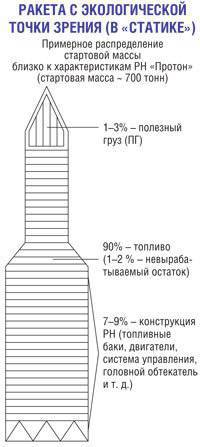"Green" cosmonautics: utopias, realities, prospects
Environmental problems of space technology and activities are becoming increasingly important. The best strategies of the future cannot be implemented without the transition to more efficient and environmentally friendly technologies. Cosmonautics has enormous potential necessary for the safety and sustainable development of mankind. However, the industry has lagged behind in eco-development, is not a leader in the field of "green" technologies and in the new global process of transition to a "green" economy and "green" growth.
The problems of environmental safety and the greening of space activities (CD) are becoming increasingly relevant. The world is transitioning from a dirty and wasteful “brown” economy to a new one — green, to green technologies and green development. The author is engaged in their research since the 90-s of the XX century and published a number of works. The most well-known book in collaboration with Professor M. Vlasov "The environmental risk of space activity" (1999).
The green economy was dedicated to the Rio + 20 world conference under the auspices of the United Nations in June 2012 in Rio de Janeiro. "Green" energy, "green" construction, "green" transport become a new and fashionable reality and a prototype of a "green" future. As an example - the "green" plane. And where is the "green" astronautics and whether the "green" space technology, technology, activity? What should be the strategy for the transition to a green space program?
"Green" technology and "green" astronautics (determine the ideal image)
“Green” technologies are technologies that allow to carry out activity goals with a minimum of resource consumption and a minimum of environmental pollution. They have the mission of ecologization of equipment and activities, are powerful catalysts for the transition to a new technological order, transformation of technological fields of activity, the economy and society.
The “green” cosmonautics ideally should use only “green” technologies, realizing the goals of the CD with minimum resources and pollution.
Why cosmonautics lagged behind in environmental development?
In April 2012 of the Year, Roskosmos presented a draft of a new space activity strategy developed in the industrial-market paradigm: boost industry, restore infrastructure, strengthen quality control, increase global market share. On environmental protection and environmental safety, there was nothing but the fight against space debris in near-earth orbit, which contradicted the new state policy of the Russian Federation in the field of environmental development. This drew public criticism of the project, including through the Open Government mechanism. In April, 2013, the Russian president, approved the basics of the new state policy of the collective agreement, where there are provisions for environmental protection (OS) and much more.
 It is extremely important to determine: what are Russia's goals and strategy in space? Fly to the moon, explore Mars? What are the needs of society, how should the space industry meet them? What should be its structure, how to organize work and effectively use resources?
It is extremely important to determine: what are Russia's goals and strategy in space? Fly to the moon, explore Mars? What are the needs of society, how should the space industry meet them? What should be its structure, how to organize work and effectively use resources?However, with the current space technology, which has a military genesis, created on the principles and technologies of half a century ago, no strategies, policies, organizational structures, money, and even new space centers will not help. There is an even more difficult problem.
A modern launch vehicle (PH) is much less efficient than a locomotive: from 100 percent of the starting mass only one - three percent - the payload, 90 percent - fuel (often this is a supertoxic asymmetrical dimethylhydrazine, UDMH, - heptyl, inherited from the cold war ), the remaining one - nine percent - fragments of the structure, flying after triggering and separation in areas of incidence. Unlike the “traditional” cosmic point of view, from an environmental point of view, a rocket is an environmentally dirty and economically wasteful technology. It is as a result of the massive use of such technologies by mankind for half a century of the space age that pollution of the Earth’s surface and near-Earth space has arisen and is growing.
The risks of accidents during missile launches are high, the probability of failure is ~ 0,03–0,05, that is, three to five launches are emergency (on average, every 25th). By the way, in aviation The efficiency of aircraft is an order of magnitude higher (~ 40%), and flight safety is three to four orders of magnitude higher than the LV. If eco-standards (Euro-1, 2, 3, 4, 5) have long been valid for automotive fuel, then they are not for rocket. The space industry in Russia and around the world is in no hurry to introduce them. Moreover, our country was overly keen on commercial launches of obsolete heptyl missiles, which was one of the negative factors that led to a lag in the development and updating of technology.
Classification and assessment of environmental technology, technology, industries
In the development of the approach published in 2007, a new approach and model are proposed, allowing to give a classification and assessment of environmental friendliness ("greenness") of equipment, technologies, processes, industries in space (coordinates): "consumption, reproduction of natural resources" - "pollution, destruction, cleaning, restoration of OS ". In simplified form, the model is shown in the figure.

The proposed classification of environmental technologies of the four classes (colors): A - "white", B - "green", C - "brown", B - "black." The boundaries between classes A and B, B and C (gray dotted line), C and D (black dotted line), and also the outer limit of class D (small dotted line) are conditional. They can change, shifting to the left and down, taking into account the change of ideas, toughening the "rules of the game" ("green" standards, etc.).
Analyzing technology, it is possible to obtain estimates of the spectra of technology objects of equipment and the entire industry. The integrated ecological-technological spectrum (IETS) of a technical object, an industry can be represented as a spectrum of technologies implemented in them, where each of the classes has its share. In the general case, the EET industry can cover several environmental regimes (ER) and technology classes in various proportions, throughout the full life cycle and covering all the equipment, technologies and processes that belong to this industry, including in a historical context. The more environmentally friendly (greener) the industry, the less black and brown in IETS and the more the spectrum is shifted to the green zone.
There is an area of best available technologies (BAT) L for industry N, which is significantly less than its EETS. Moreover, not all NDT are “green”, which is caused by the existing technological structure, reflects the complex collision of the real structure and activity of the industry, the transition process from “black” and “brown” technologies to “green”.
Environmental safety assessment is correlated with ITEC.
Environmental safety in this model is divided into four levels corresponding to the classes of technologies (from “white” to “black”), and should cover several classes, it should be assessed by the worst indicator.
Applied to space technology and technologies using the example of fuel in the composition of fuels used in the LV, the technology classes look like this: “black” - heptyl PH (NDMG + nitrogen tetraxide), “brown” - kerosene PH (kerosene + oxygen), “green” - hydrogen PH (hydrogen + oxygen), "white" - promising fundamentally new ("no missile") equipment and technology (electromagnetic, gravitational, etc.). As a fantastic prototype: “white and fluffy” innovative “gravitsappa” from the Soviet film “Kin-Dza-Dza!” (1986 year).
According to preliminary estimates, in the space industry, “black” and “brown” technologies and the corresponding technical objects clearly dominate.
The management of the process of ecologization of space technology and the level of environmental safety should be carried out through the management of the spectrum of applied technologies. But first, it is necessary to make an inventory of the whole range of technologies used in the industry, and assess specific proportions and trends.
What is the ecological color of the new Vostochny cosmodrome?
Creation of the Vostochny cosmodrome (main territory ~ 1000 sq. Km, from the Russian budget are allocated ~ 300 billion rubles., 1-th launch of the Soyuz-2 launch vehicle according to plan in 2015 year, and in 2018-th - 1-th manned flight) It is by decree of the President of the Russian Federation; it is important for the implementation of the new state policy of the CD, the development and security of the Amur Region, the Far Eastern Federal District (DFO) and the whole country. The new Russian cosmodrome has a long and complex prehistory: at this point, since 60-s of the 20th century, there was a division of the Strategic Missile Forces (RVSN) of the USSR Ministry of Defense (MO) of the Russian Federation, at the beginning of 90-x disbanded, then at its base created the Free Spaceport (1996 – 2006). Due to a number of reasons, this cosmodrome was not developed (only five launches of satellites with solid-propellant rockets) and, by decision of the President of Russia, was closed and eliminated in 2006 in the year.
 In 2007, a new initiative emerged to create an innovative project for the national cosmodrome and space center of Russia, which would become the core of the “space” cluster in the DFO.
In 2007, a new initiative emerged to create an innovative project for the national cosmodrome and space center of Russia, which would become the core of the “space” cluster in the DFO.It is advisable to consider the new Vostochny cosmodrome as an object of socio-ecological and economic management in the innovative model of the future CD, the Amur Region, the Far Eastern Federal District and the whole of Russia in the new paradigm of sustainable “green” development, “green” economy, “green” technologies. This implies a balance, accounting and implementation of all three blocks (social, environmental, economic) in the project, in the process of its implementation and further on the full life cycle of a given strategic object.
Unfortunately, the creation of the Vostochny cosmodrome is still going on in the old paradigm, using obsolete technologies, with violations of the requirements of the new state policy of the Russian Federation in the field of eco-development. In such a scenario, the ecological color of the new cosmodrome will be far from green. It must be admitted: the cosmodrome project did not initially assume the use of “green” technologies, pre-ecological technical and infrastructural logic prevailed, it is being implemented in a shortage of time, in a hurry, in parts, without full ecological expertise.
It is necessary not only to achieve efficient spending of funds and meeting construction deadlines, but above all to adjust the project and the whole process of creating the Vostochny cosmodrome, which in the future can become an effective innovative and “green” object, a multiplier for the development of the CD sphere.
The space industry needs a “green” technological breakthrough
In July, the 2013 of the Baikonur Cosmodrome crashed the heptyl RON Proton-M crash, three GLONASS satellites were lost, and the damage amounted to about five billion rubles. Fortunately, there were no casualties. Environmental damage, according to estimates by the Kazakh side, amounted to ~ $ 89 million.
But even if a miracle happens: the rocket stops falling and all 100 percent of launches become successful, the new Vostochny space center will be built and will work at full power, this will not change this situation radically.
The space industry needs a “green” technological breakthrough: reusable rockets, with high mass efficiency, without toxic fuels, returnable stages for which no areas of incidence are needed, etc. Development of such rockets, fuels, new technologies, but a transition to he lingered in Russia and the world for years on 20 (!). The space industry (both in Russia, in the USA and in China) is clearly lagging behind in eco-development. Already trying, but still can not get rid of the toxic fuel from hydrazine-heptyl and disposable missiles. However, the “green” space future does not shine on the “black” wasteful technology.
Any proven technology is cheaper than a new one; for technological breakthrough, political will, demands and incentives are needed. And it is unlikely in the modern world space market it is possible in a single country, even with effective management. It is necessary to change not separate technologies, but the whole technological structure from “black” to “green”.
But if, for example, Roskosmos was itself a customer, performer and controller, managing the entire space industry, and the industry was underfunded for a long time, then problems with product quality, safety, innovation, personnel and the general crisis in the industry naturally increased: too often missiles, equipment is updated very slowly (the new Angara PH is created from 1994, with a big delay: more than 20 years!). In 2013, the reform of the entire sphere of the CD of Russia began and is gaining momentum; the United Rocket and Space Corporation has been created. And it turns out that now it’s not up to “fat”, not up to ecological “frills”?
However, the situation is even worse. The world is moving towards a green economy in the new paradigm of green development and growth along the lines of Rio + 20 (2012 year). Develop "green" energy and transport. New requirements are also growing for the space industry to introduce the best available technologies, green rockets and new technologies for moving in space. The one who quickly realizes and leads this process will become the real world leader of the new - “green” wave of cosmonautics and space activity in the 21st century.
The development strategy of "green" space
Is a “green” transition of the CD sphere possible and what should be the general model, the structure of the development strategy of “green” astronautics?
Utopia. Since 90-ies of the XX century, there exist and develop ideas of ecologization of space technology, technologies, design companies, in the 10-ies of the XXI century, they can be represented as a set of ideas about the possibility of a radical, rapid transition to green astronautics by updating technology “Green” technologies, etc. A variety of ideas and innovative CD technologies have been developed that can be classified as “green” (for example, non-toxic rocket fuels, the use of energy transmitted by a laser beam for rocket movement, “space elevator”, etc.). In Russia, the proposed concept of "green" technologies CD, "green" strategy for the exploration of the moon. But their implementation is difficult because of the predominance of outdated "pre-environmental" approaches, technology, technology and technological structure in the field of collective agreements. "Green" astronautics is still perceived as a utopia.
Realities. Modern space equipment, technologies, and CD in Russia and the world have inherited environmental problems due to the military genesis, the presence of dual technologies, the lag in the implementation of environmental standards, the transition to the best available technologies, and also due to economic and other restrictions. Existing “traditional” projects, programs, and CD strategies do not pay enough attention and resources to ensuring environmental safety and environmental protection. Green approaches and technologies are not reflected in them yet. We are stuck on the important problem of “space debris” in near-Earth space, but we cannot solve it either, because we need to change - to ecologize the entire CD system. The development strategy for green space will be developed as an alternative to the existing CD strategy and / or addition to it.
Perspectives. The general model of the “Green Cosmonautics Development Strategy” can be presented in the form of 3 units: 1. Goals, objectives, principles. 2. The main directions, methods, approaches. 3. Stages.
Consider the 2 block in more detail. Main areas: 1) ensuring environmental safety; 2) use of natural resources on Earth and in space; 3) protection and restoration of the environment, including the creation of specially protected spaces outside the Earth. Key methods: rationing and classification of environmental friendliness of equipment, technologies, projects and CD programs in the form of 4 classes. The main approaches: 1) system approach; 2) full life cycle coverage; 3) transition to a "green" technological structure through the management of a range of technologies: banning the "black" class, limiting the "brown", active support for the "green" and advanced development of the "white".
Briefly about the 3 block. Stages: 1) development and implementation of new "rules of the game" (rationing, etc.); 2) transition period (from the "black-brown" astronautics to the "green"). 1-th stage ~ 5 years, 2-th ~ 20 – 30 years (optimistic scenario).
The ideology, structure and logic of the “green” strategy can be represented as a system (hierarchy): (1) “green” policy> (2) “green” economy> (3) “green” standards> (4) “green” technologies> (5) "green" technological order.
However, the “green” transition is impossible only in astronautics and / or in one country, it is determined by the pace of development of the global “green” economy. But the lag will lead to a decrease in the efficiency and competitiveness of the CD field, and without “green” astronautics, there will be no “green” future of humanity.
You can paint rockets with green paint and hang green space flags, but this does not solve the problem.
All cosmonautics in Russia and the world, its infrastructure and products should be started from the new “green” test - “green” ideas, rules of the game, projects, materials. To do this, all participants in the process have to "turn green" from the inside.
It remains to understand, want to manage!
Information